Module 1
| Site: | MoodleHUB.ca 🍁 |
| Course: | Physics 30 SS |
| Book: | Module 1 |
| Printed by: | Guest user |
| Date: | Monday, 15 December 2025, 9:59 PM |
Description
Created by IMSreader
1. Module 1
Module 1—Momentum and Impulse
Module Introduction

Steve Allen/Brand X Pictures/Getty Images
In this module you will work with the relationship between Newton’s laws of motion and momentum. You will apply these concepts in the context of the design and function of modern vehicle safety devices.
1.1. Big Picture
Module 1—Momentum and Impulse
 Big Picture
Big Picture
According to the August 2007 Canadian Vehicle Survey conducted by Statistics Canada, there were an estimated 2 533 947 vehicles in Alberta. This number includes an estimated 113 729 vehicles that had masses in the range of 4.5-tonne delivery trucks to 14.9-tonne tractor semitrailers.

© Manfred Steinbach/shutterstock/2939101
Considering the mass of all of the vehicles, and the velocity at which those vehicles travel, there is plenty of momentum on Alberta’s roads. Given the large number of vehicles, there is little doubt that accidents involving large forces and changes in momentum will be experienced by the human occupants of colliding vehicles.
Consider the crash test dummy. Smashed, crushed, bent, and battered, the dummy serves as a simulated human being that does not experience the real pain and cost of a vehicle collision.
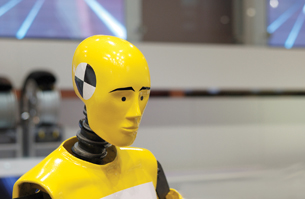
© trialart-info/shutterstock
Crash test dummies are the lone occupants of a vehicle travelling at high velocity, with a large amount of momentum, only to change their momentum dramatically when the vehicle makes contact with another vehicle or barrier. In the collision, forces act to change the momentum of the vehicle and occupant, testing the effectiveness of safety systems, such as air bags and crumple zones, in the vehicle.
But before a vehicle races down the track to certain destruction during collision testing, investigators need to understand how the concepts of momentum and impulse can be applied to understand the function and design requirements of vehicle safety devices.
As you are working in Module 1, keep the following questions in mind:
-
What do we really mean when we say “speed kills”?
-
How is it possible to reduce injury and death when a vehicle occupant experiences a large change in momentum during a collision?
In this lesson you will be working with vectors as you did in Physics 20. During the lesson, before you have any vector questions, there is an opportunity for you to review vector addition.
 Module Assessment
Module Assessment
Each lesson has a teacher-marked assignment based on work completed in the lesson. In addition, you will be graded on your contributions to the Discuss section of each lesson.
You will also be asked to complete Self-Check or Try This questions, which you should place in your Physics 30 course folder. These are not formally assessed but are a valuable way to practise the concepts and skills of the lesson. These activities can provide you with reflective feedback on your understanding of the lesson work.
You will be marked for your lesson work on the following items:
-
Module 1: Lesson 1 Assignment
-
Module 1: Lesson 2 Assignment
-
Module 1 Project
In the context of each lesson, you will explain why “speed kills” and how modern vehicle safety devices work to reduce the force experienced by vehicle occupants involved in a collision.
After you have completed both lessons, you will do a module assessment that consists of three questions similar to diploma exam written response questions. These questions will require you to apply your knowledge and skills to a practical application of momentum in a crash test scenario. As this is your first module assessment, make sure that you read the marking rubrics and the self-evaluation questions to be sure that you have answered the questions completely and understand what will be evaluated.
If at any point you are having any concerns or difficulties, contact your teacher for specific feedback.
1.2. In this Module
Module 1—Momentum and Impulse
In This Module
Lesson 1—Momentum and Newton’s Second Law
In this lesson you will define the vector quantity momentum and its relationship to Newton’s laws and address what we really mean when we say “speed kills.” To do this, you will explore the following questions:
-
What is momentum?
-
Why is momentum defined as a vector?
-
How is momentum related to Newton’s laws?
Lesson 2—Impulse: Changing Momentum
In this lesson you will explore how it is possible to reduce injury and death when a vehicle occupant experiences a large change in momentum during a collision through the function of vehicle safety features. To better understand this, you will explore the concept of momentum and its relationship to Newton’s second law. In this lesson you will explore the working principles of safety devices in the context of the following questions:
-
What is impulse?
-
How is impulse related to a change in momentum?
-
How is impulse related to Newton’s laws?
1.3. Lesson 1
Module 1—Momentum and Impulse
Lesson 1—Momentum and Newton’s Second Law
 Get Focused
Get Focused
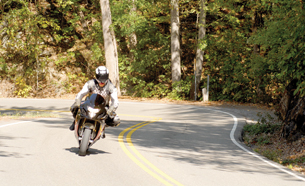
© David P. Smith/shutterstock
The motorcycle has been popular for a long time. Driving a motorcycle has been compared to riding a horse because the rider is completely exposed to the elements. It’s also like flying a small aircraft because it’s “a full-body experience.” It requires a feel for the road—leaning into turns and constantly making adjustments for changing road conditions.
There is, however, very little protection for the rider if a crash occurs. Consider the typical motorcycle fatality in Canada. It seems to have a common profile—single vehicle, summer weekend evening, rural road with a posted speed limit over 90 km/h. Motorcycle fatalities in Alberta more than doubled between 2000 (14 fatalities) and 2006 (32). Sadly, the annual number of motorcycle driver deaths is on the increase. Statistics indicate that one contributing factor is the increasing number of very powerful, high-performance motorcycles. Compare the two bikes pictured here.

© John Neff/shutterstock (speeder on highway)
© ann trilling/shutterstock (woman on bike)
The death rate for people riding high-performance motorcycles is about three times that of people riding lower-powered machines. Why do you think that is? Could the phrase “speed kills” apply here?
Part of the answer to this question involves exploring the concept of momentum and how it is related to the vector quantity velocity and the scalar quantity mass.
In this lesson you will answer the following essential questions:
- What is momentum?
- Why is momentum defined as a vector?
- How is momentum related to Newton’s laws?
 Module 1: Lesson 1 Assignment
Module 1: Lesson 1 Assignment
Your teacher-marked Module 1: Lesson 1 Assignment requires you to submit responses to the following:
- Assignment—A 1, A 2, A 3, A 4
- Discuss—D 1, or D 2, or D 3
- Reflect on the Big Picture
The other questions in this lesson are not marked by the teacher; however, you should still answer these questions. The Self-Check and Try This questions are placed in this lesson to help you review important information and build key concepts that may be applied in future lessons.
After a discussion with your teacher, you must decide what to do with the questions that are not part of your assignment. For example, you may decide to submit to your teacher the responses to Try This questions that are not marked. You should record the answers to all questions in this lesson and place those answers in your course folder.
1.4. Page 2
Module 1—Momentum and Impulse
 Explore
Explore

© Lisa Kyle Young/iStockphoto
What's the most important piece of equipment for reducing the severity of injuries caused by a motorcycle collision? Most experts agree that it's a well-designed helmet. Approved helmets are designed to withstand the very large forces that can occur at the point of impact. As you learned in previous courses, an unbalanced force always acts when a mass undergoes a change in velocity. A change in velocity could mean a change in the magnitude of the velocity, resulting in the object speeding up or slowing down. A change in velocity could also mean a change in direction. You can learn more about factors that affect the directions of two objects after a collision in the next activity.
 Read
Read
To find out more about collisions, read page 446 of your textbook.
 Try This
Try This
Follow the instructions and complete “9–1 QuickLab: Predicting Angles After Collisions” on page 447 of your textbook. As you make observations and collect data, use the questions at the end of the activity to help guide your work.
TR 1. Answer question 1 at the end of the QuickLab.
TR 2. Answer question 3 at the end of the QuickLab.
Momentum

© Kinetic Imagery/shutterstock
You can use the word momentum in everyday language to describe various events—sporting events, political campaigns, or economic trends. However, regardless of what is being described, the word momentum always implies sustained movement. For example, the expression “Team X has gained momentum” means that the team is “on the move” and will be difficult to stop— the greater the momentum, the harder it is to stop the team.
In physics, the word momentum has a similar meaning but it is related to the quantity of motion possessed by an object.
momentum: the product of the mass and velocity of an object
Expressed as an equation, it is ![]() .
.
 Read
Read
You can find out about the exact meaning of the word momentum in physics by reading pages 448 and 449 of your textbook.
 Self-Check
Self-Check
SC 1. Produce a short summary that includes the key ideas about momentum.
 Self-Check Answer
Self-Check Answer
SC 1.
Momentum is the product of the mass and velocity of an object.
Expressed as an equation it is ![]()
Quantity |
Symbol |
SI Unit |
momentum |
|
kg·m/s |
mass |
m |
kg |
velocity |
|
m/s |
Since momentum is the product of a vector (velocity) and a scalar (mass), it is a vector quantity. The direction of the momentum vector is in the same direction, as the velocity of the object.
Problem Solving with Momentum
When solving problems, it is useful to follow the GRASP model for problem solving. The GRASP model is on page 867 in your textbook.
Since momentum is a vector, it is very important to clearly communicate direction. Note how a sign convention is used to handle direction in each of the following examples.
Example Problem 1

Determine the momentum of a vehicle with a mass of 2100 kg moving at a velocity of 22 m/s, east.
Given

Required
The momentum of the vehicle, ![]() .
.
Analysis and Solution
Let east be the positive direction.

Paraphrase
The momentum of the vehicle is 4.6 × 104 kg·m/s [E].
Example Problem 2
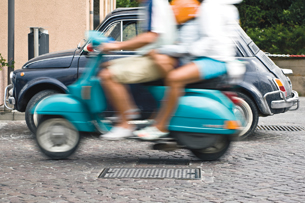
© Claudio Arnese/iStockphoto
In many countries motorized scooters are a very popular form of transportation. The total momentum of two people on a scooter is 7.20 × 103 kg·m/s [S]. If the combined mass is 250 kg, determine the velocity of the people on the scooter.
Given

Required
The velocity of the vehicle, ![]() .
.
Analysis and Solution
Let south be the negative direction.
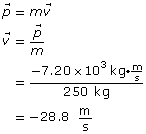
Paraphrase
The velocity of the motorcycle and riders is 28.8 m/s [S].
Example Problem 3
An airplane has a momentum of 8.3 × 107 kg·m/s [N]. If the airplane is flying at a velocity of 990 km/h [N], determine its mass.
Given
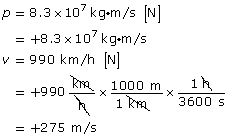
Required
The mass of the airplane, m.
Analysis and Solution
Let north be the positive direction. This solution involves dividing momentum by velocity. Recall that multiplying or dividing one vector by another is beyond the scope of high school physics. Therefore, the vector notation is dropped.
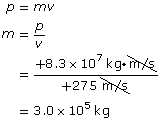
Paraphrase
The mass of the airplane is 3.0 × 105 kg.
Scalars and Vectors
As you saw in the example problems, the vector nature of momentum plays a significant role in problem solving. If you’d like a review of vectors and the use of vector notation, take a few minutes to complete this vector review. If you feel confident in your understanding of vectors and the use of vector notation, continue on with the lesson.
 Self-Check
Self-Check
SC 2. What is a scalar quantity? Give two examples.
SC 3. What is a vector quantity? Give two examples.
SC 4. The following diagram shows a ship being towed out of a harbour by two tugboats.
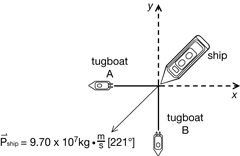
The momentum of the ship is 9.70 x 107 kg·m/s [221°]. What is the component of the momentum provided by tugboat A? What is the component of the momentum provided by tugboat B?
SC 5. Calculate the momentum of a 70.0-kg person travelling west at 5.0 m/s.
SC 6. A motorcycle has a velocity of 95 km/h [N] and a momentum of 7250 kg·m/s [N]. Determine the mass of the motorcycle.
 Self-Check Answer
Self-Check Answer
SC 2. A scalar quantity is a measurement that has magnitude only. Examples include time and mass.
SC 3. A vector quantity has both magnitude and direction. Examples of vectors include velocity, force and acceleration.
SC 4.
Given
![]()
Required
The component of the momentum provided by tugboat A, ![]() ship x.
ship x.
The component of the momentum provided by tugboat B, ![]() ship y.
ship y.
Analysis and solution
The momentum of the ship is provided by two tugboats. Tugboat A provides the component in the negative x direction. Tugboat B provides the component in the negative y direction. The component can be determined by using trigonometry.
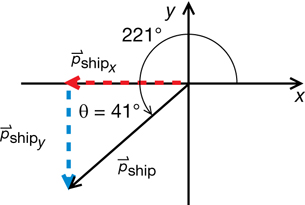
Momentum |
X component |
Y component |
|
|
|
Paraphrase
The component of the momentum provided by tugboat A is ![]() , in the negative x direction.
, in the negative x direction.
The component of the momentum provided by tugboat B is ![]() , in the negative y direction.
, in the negative y direction.
SC 5.
Given

Required
The momentum of the person, ![]() .
.
Analysis and Solution
Let west be the negative direction.

Paraphrase
The momentum of the person is
SC 6.
Given
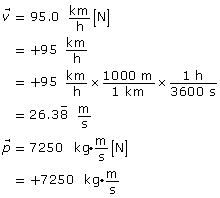
Required
The mass of the motorcycle, m.
Analysis and Solution
Let north be the positive direction.
This solution involves dividing momentum by velocity. Dividing one vector by another is beyond the scope of high school physics so the vector notation is dropped.
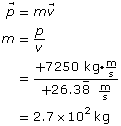
Paraphrase
The mass of the motorcycle is 2.7×102 kg.
 Module 1: Lesson 1 Assignment
Module 1: Lesson 1 Assignment
Remember to submit the answers to A 1, A 2, A 3, and A 4 to your teacher as part of your Module 1: Lesson 1 Assignment.
 Assignment
Assignment
A 1. Use reasoning to determine if one of the following objects in each of these pairs has a greater value for the magnitude of its momentum than the other. (No calculations should be required.)
-
a 900.0-kg truck travelling at 60 km/h, or a 500.0-kg car travelling at 60 km/h
-
a 15.0-kg object travelling to the right at 5.0 m/s, or a 15.0-kg object travelling to the left at 5.0 m/s
-
a 900-kg truck at rest, or a 500-kg car at rest
-
a 900-kg truck at rest, or a mosquito flying at 2 m/s
A 2. Solve question 9 on page 453 of your textbook.
A 3. Solve question 12 on page 453 of your textbook.
A 4. Solve question 15 on page 453 or your textbook.
1.5. Page 3
Module 1—Momentum and Impulse
Momentum and Newton’s Second Law
Recall that Newton’s second law states that if an external, non-zero, net force acts on an object, it will accelerate. Acceleration means a change in velocity, which means a change in momentum! The external unbalanced force, therefore, causes a change in momentum. In other words, if there’s an ![]() , there’s a
, there’s a ![]() . Therefore, Newton’s second law and momentum are related to one another.
. Therefore, Newton’s second law and momentum are related to one another.
 Read
Read
Find out more about the connection between momentum and Newton's second law of motion by reading pages 450 to 452 in your textbook.
 Self-Check
Self-Check
SC 7. Show the derivation of Newton's second law in terms of the change in momentum.
 Self-Check Answer
Self-Check Answer
SC 7.
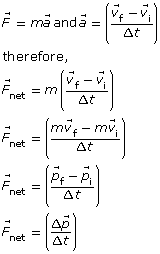
![]()
In this form, Newton’s second law tells us that the external, non-zero, net force acting on an object will be equal to the rate of change of the momentum of that object with respect to time. For example, in order to change the momentum of a large mass, such as a passenger car (even if it is moving at a low velocity), in a short time, a very large net force will be required. The same is true for a smaller mass, such as a motorcycle if it travels at high velocity. In this form of Newton’s second law, the mass, the time interval and the velocity of the object (momentum) are considered.
 Reflect and Connect
Reflect and Connect

© Mikael Damkier/shutterstock
A moving vehicle has a momentum defined by the product of its mass and velocity. Changing either of these two quantities will cause a corresponding change in the momentum. Both the mass and average velocity of modern vehicles is much larger than those of the past. This means that the amount of momentum on today’s busy freeways is increasing. And according to Newton’s second law, a large net force is required to make a large change in momentum quickly. In effect, this means that the modern car crash that involves a larger vehicle and/or one travelling at a high velocity will generate larger net forces since the time of the collision hasn’t changed.
Can you think of what implications this has for both vehicle design and safety? Larger vehicles and/or those that travel at a high rate of speed require larger engines and brake systems and stronger steering systems. All of these design features are required to change large amounts of momentum in short periods of time.
 Module 1: Lesson 1 Assignment
Module 1: Lesson 1 Assignment
Remember to submit the answers to D 1 or D 2 or D 3 to your teacher as part of your Module 1: Lesson 1 Assignment.
 Discuss
Discuss
In the discussion forum, use the concepts of momentum and Newton’s second law to explain why the following statements are true.
D 1. A large freight train moving down the tracks takes a long time to stop.
D 2. A motorcycle can have the same momentum as a large truck.
D 3. In general, a motorcycle can accelerate at a greater rate than a large truck.
You may want to review the discussion rubric for the assessment criteria in posting and responding to discussions.
| Principles involved: momentum | ||||
Criteria |
Level 1 (Below Standard) |
Level 2 (Approaching Standard) |
Level 3 (Standard) |
Level 4 (Above Standard) |
| Knowledge | ||||
| Demonstrates understanding of the situation, physics principles and technology, and their connections. | Demonstrates a vague and sometimes incorrect understanding of the physics principles involved. Obvious irrelevant or missing information. | Demonstrates a basic understanding of the physics principles involved. May exhibit minor mistakes or vague information or application to the situation. | Demonstrates a good understanding of the physics principles involved and applies them properly to the given situation. All necessary information is given. | Demonstrates a superior understanding of the physics principles involved and their application to the situation. All applications are considered in detail. |
| Reflection | ||||
| The post shows reflection on one’s own and other students’ work. Contributes to the group discussion. | Does not make an effort to participate. Seems indifferent to discussion. | Occasionally makes meaningful reflections on the group’s efforts or discussions. Marginal effort is shown to become involved with the group or discussion. | Frequently makes meaningful reflections on the group’s efforts and presents relevant viewpoints for consideration by the group. Interacts freely with group members. | Regularly attempts to motivate the group discussion and delve deeper into concepts. Interacts freely and encourages all group members. |
| Content and presentation of discussion summary | ||||
| The information is logically arranged in a clear and concise manner. | The information is poorly organized with many concepts implied. Irrelevant or rambling sentences make reading difficult. | The information is somewhat organized with implied concepts. Excessive words or awkward sentences are used, which hinder reading. | The information is well-organized and logically arranged. All concepts are explicitly explained. There are a few awkward but understandable sentences. | The information is well- organized and very easy to understand. Well-worded sentences make reading pleasurable. |
Once you have submitted your explanations, read at least two other postings. Consider how well these responses used the concepts of momentum and Newton’s second law. Reflect on your responses and the two others you have read. Choose one of the responses, revise your response and submit both the original and the revised response to your teacher.
 Module 1: Lesson 1 Assignment
Module 1: Lesson 1 Assignment
Remember to submit the answer to Reflect on the Big Picture to your teacher as part of your Module 1: Lesson 1 Assignment.
 Reflect on the Big Picture
Reflect on the Big Picture
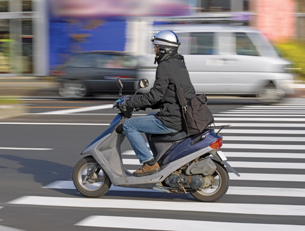
© Radu Razvan/shutterstock
In real life, a police officer may warn that “speed kills.” In video games, high-speed crashes are common. Suppose a particular scene in a game requires the following elements:
-
A high-performance motorcycle must crash into a barrier and be stopped.
-
A small scooter must crash into another section of the same barrier and be stopped.
-
The forces exerted as each vehicle collides with the barrier change the shape of that section of the barrier in addition to stopping the vehicle.
-
The time required to stop each vehicle must be realistic.
Create a paragraph, illustration, animation, or audio recording to explain how you could use the concept of momentum and net force to make each simulated crash realistic. In general, how could you use momentum and Newton's laws of motion to predict the amount that each section of the barrier changes shape?
Store your completed reflection in your Physics 30 course folder, and submit your creation to your instructor for marking.
 Module 1: Lesson 1 Assignment
Module 1: Lesson 1 Assignment
Submit your responses to the following parts of your Module 1: Lesson 1 Assignment to your teacher:
- Module 1: Lesson 1 Assignment
- Assignment —A 1, A 2, A 3, A 4
- Discuss—D 1, or D 2, or D 3
- Reflect on the Big Picture
 Lesson Summary
Lesson Summary
In this lesson you explored the following questions:
-
What is momentum?
-
Why is momentum defined as a vector?
-
How is momentum related to Newton’s laws?
Momentum is the product of an object’s mass and velocity.
Since momentum is the product of a vector (velocity) and a scalar (mass), it is a vector quantity. The direction of the momentum vector is in the same direction and is relative to the same reference frame as the velocity of the object.
Newton’s second law tells us that the external, non-zero, net force acting on an object will be equal to the rate of change of the momentum of that object with respect to time. This has particular relevance to situations involving large changes in momentum, such as those of vehicle collisions. In the next lesson you will learn how effective vehicle safety devices can be designed based on the same principles.
Lesson Glossary
momentum: is the product of the mass and velocity of an object
Expressed as an equation it is
1.6. Lesson 2
Module 1—Momentum and Impulse
Lesson 2—Impulse: Changing Momentum
 Get Focused
Get Focused
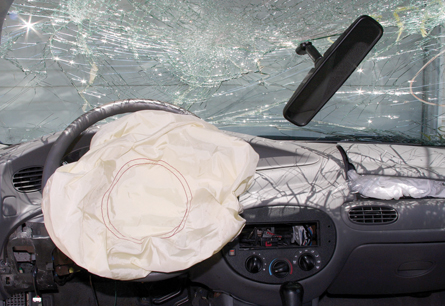
© Melissa Brandes/shutterstock
In Lesson 1 you learned that large, heavy vehicles or those that travel at high rates of speed have considerable momentum. In the event of a sudden stop, such vehicles will experience a large change in momentum. In the instant prior to the collision, the occupant of a vehicle has the same velocity as the vehicle. For example, the velocity could have been more than 100 km/h. Very shortly after the collision, the vehicle and the occupant would have had a very different velocity—probably zero. Both the vehicle and occupant experienced a huge change in momentum during this collision. How is it possible to reduce injury and death when an occupant in a vehicle experiences a large change in momentum during a collision?
Recall what you learned in Lesson 1. A force is required to change the momentum of the occupant. How can you limit the damage caused by this force? Seat belts and airbags both can play a major role in limiting damage to the occupant. How are Newton’s laws of motion applied to the designs of these devices?
To understand this correctly, we need to explore the concept of impulse and how it relates to a change in momentum and Newton’s laws of motion.
In this lesson you will explore the following essential questions:
-
What is impulse?
-
How is impulse related to a change in momentum?
-
How is impulse used in the design of safety devices that protect the occupants of vehicles during a crash?
 Module 1: Lesson 2 Assignment
Module 1: Lesson 2 Assignment
Your teacher-marked Module 1: Lesson 2 Assignment requires you to submit responses to the following:
-
Assignment—A 1, A 2, A 3, and A 4
-
Discuss—D 2
You must decide what to do with the questions that are not marked by your teacher.
Remember that these questions provide you with the practice and feedback that you need to successfully complete this course. You should respond to all the questions and place those answers in your course folder.
1.7. Page 2
Module 1—Momentum and Impulse
 Explore
Explore

© Joe Gough/shutterstock
People who ride motorcycles do not have the protection of airbags if they are involved in a crash. So other safety features are used to reduce injuries in this case.
Helmets are an essential component of the safety systems that protect people who ride motorcycles. The role of the cushioning in the lining of the helmet is explored in the next activity.
 Try This
Try This
Complete “9-2 QuickLab: Softening the Hit” on page 455 of your textbook. If you do not have access to putty-type material, you can try one of these recipes for playdough.
 Self-Check
Self-Check
SC 1. Answer questions 1, 2, and 3 of the QuickLab on page 455 of your textbook.
Hint: In your answer to question 3, start with this equation,![]() .
.
 Self-Check Answer
Self-Check Answer
SC 1.
- The putty ball that landed on the hardest surface was the most deformed. The putty ball that landed on the surface that was the most cushioned was the least deformed. The putty ball that landed on the third surface—having intermediate cushioning—experienced an intermediate amount of deformation.
- The putty ball that landed on the hardest surface was the most deformed. The putty ball that landed on the most-cushioned surface was the least deformed.
- The instant prior to striking the surface, the putty ball had an initial velocity. Once contact was made with the surface, the putty ball began to decelerate and it eventually came to a stop, making vf = 0. The time to bring the ball to a stop is Δt, and the distance required to stop the ball is Δd. The cushioning material is compressed this distance (Δd) while stopping.
Look at the following analysis of the equation. It shows that the greater the compression of the material, the greater the stopping distance. This shows that the time interval required to bring the ball to a stop is greater.

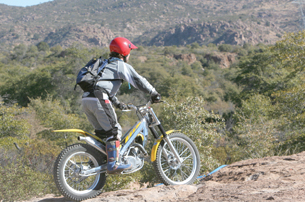
© Casey K. Bishop/shutterstock
The QuickLab demonstrated that if cushioning is present as an object loses its momentum and comes to a stop, then the forces required to stop the object can be reduced. In the case of the putty ball, the evidence of the magnitude of the stopping force is the amount of deformation of the ball.
Since a motorcyclist rarely travels over cushioned surfaces, the motorcyclist must carry his or her own cushioning—it's in the lining of the helmet. This cushioning helps to reduce the negative impact of forces acting on the rider’s head during a crash.
 Read
Read
To learn more about the connections between the type of surface and the severity of injuries, read pages 454 to 456 in your textbook. Pay close attention to the relationship between stopping time and force on page 456.
 Self-Check
Self-Check
SC 2. Explain why maximizing the stopping time has the effect of minimizing the stopping force.
 Self-Check Answer
Self-Check Answer
SC 2.
In the previous lesson you learned that Newton's second law can be expressed in terms of the change in momentum.
![]()
If this equation is rearranged, it can be shown that the change in momentum is equal to the net force multiplied by the time interval.

If identical eggs are dropped from the same height onto a surface, the change in momentum will be identical for both eggs. However, if the stopping time interval for one egg is maximized, then the force that egg experiences can be minimized.
1.8. Page 3
Module 1—Momentum and Impulse
Impulse
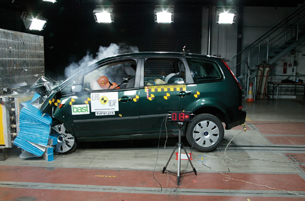
© Courtesy of ADAC.de
impulse: the product of the net force applied to an object and the time interval during an interaction
The equation is as follows:
![]()
Whether you stop a crash test dummy in a vehicle with an airbag or stop a putty ball with a cushioned surface, the combination of force acting over a time interval plays the essential role. That is why the product of the force and the time interval during which the force acts is given a special name—impulse.
|
|---|
The unit for impulse is N·s, which is the same as the unit for momentum, kg·m/s, since N = kg·m/s2.
|
Impulse is a different kind of quantity because it does not have its own symbol. Instead, impulse is either represented by the word impulse or the variables ![]() This helps remind you that many combinations of a force acting over a time interval can provide a specific amount of impulse.
This helps remind you that many combinations of a force acting over a time interval can provide a specific amount of impulse.
 Read
Read
You can learn more about impulse and how it can be calculated by reading pages 457, 458, and the top half of page 459 in your textbook. Pay particular attention to the calculations shown in “Example 9.3.”
SC 3. Use Newton's second law to identify the two different ways of calculating impulse.
SC 4. Complete the following chart to summarize the symbols and units for each of the quantities that you have learned so far in this module.
Quantity |
Symbol |
SI Unit |
|---|---|---|
impulse |
||
net force |
||
time interval |
||
momentum |
||
mass |
||
velocity |
SC 5. Do “Practice Problems” 1 and 2 on page 458 of your textbook.
 Self-Check Answers
Self-Check Answers
SC 3.
The following equations show how Newton's second law reveals two ways of calculating impulse.

SC 4.
Quantity |
Symbol |
SI Unit |
|---|---|---|
| impulse |
|
N·s or kg·m/s |
| net force |
|
N |
| time interval |
|
s |
| momentum |
|
kg·m/s |
| mass | m |
kg |
| velocity |
|
m/s |
Note that impulse, net force, momentum, and velocity are all vector quantities, so the symbol for each of these quantities includes an arrow.
SC 5.
Solution to Problem 1
Given

Required
-
the impulse provided to the car,

-
the change in velocity of the car,

Analysis and Solution
Let south be the positive direction.
Paraphrase
The impulse provided to the car is 728 N·s [S].
The velocity of the car changes by 0.662 m/s [S].
Solution to Problem 2
Given
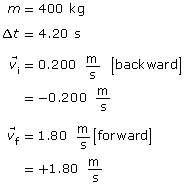
Required
The average net force acting on the dog team.
Analysis and Solution
Let forward be the positive direction.
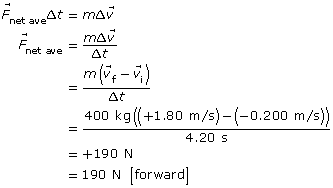
Paraphrase
The net force acting on the dog team is 190 N [forward].
 Module 1: Lesson 2 Assignment
Module 1: Lesson 2 Assignment
Remember to submit the answers to A 1 and A 2 to your teacher as part of Module 1: Lesson 2 Assignment.
A 1. An arrow gains a momentum of 94.3 kg·m/s [W] in 0.400 s. Determine the magnitude and direction of the average unbalanced force acting on the arrow.
A 2. An artillery shell is accelerated from rest and gains a momentum of 2.00 x 103 kg·m/s [E]. If the average net force acting on the shell is 8.50 x 103 N [E], then calculate the time interval that this net force acts on the shell.
Calculating Impulse from Graphs
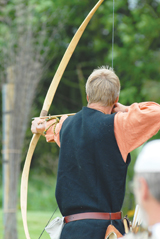
© Bodil1955/shutterstock
When the archer in this photograph releases the arrow, the force exerted by the bow on the arrow will not be constant. The following graph shows the magnitude of the net force on the arrow during the first part of its release. How do you think you could determine the magnitude of the impulse in a case like this?

 Read
Read
You can find out more about how to determine the magnitude of the impulse from a force-time graph by reading from the middle of page 459 to the bottom of page 460.
 Self-Check
Self-Check
SC 6. Return to the graph describing the net force on the arrow vs. time shown earlier in this lesson. Use the information on that graph to determine the magnitude of the impulse acting on the arrow.
 Self-Check Answer
Self-Check Answer
SC 6.

Given

Required
The magnitude of the impulse, ![]() .
.
Analysis and Solution
The magnitude of the impulse is equal to the area under a net force versus time graph.

Paraphrase
The magnitude of the impulse is 14 N·s.
 Read
Read
You can use the area under a graph to determine the magnitude of impulse. However, in some circumstances, the area under the graph is not easy to determine. Read pages 461 and 462 of your textbook to learn more about applications and limitations. Pay close attention to “Example Problem 9.4.”
 Try This
Try This
TR 1. Solve practice problem 1 on page 462 of your textbook.
TR 2. How can you get a negative area on a graph and what does it mean in terms of impulse?
 Module 1: Lesson 2 Assignment
Module 1: Lesson 2 Assignment
Remember to submit the answers to A 3 to your teacher as part of Module 1: Lesson 2 Assignment.
A 3. A high school football player hits and pushes a tackling dummy during practice. The following graph shows the amount of net force that acts on the player.

- What happens to the player’s forward velocity during the first 0.20 s?
- What happens to the player’s velocity from 0.20 to 1.20 s?
- What is the impulse that acts on the football player?
- If the 60-kg player is running forward at 7.0 m/s when she makes contact with the dummy, what is the player’s velocity at the end of the 1.20 s impact?
1.9. Page 4
Module 1—Momentum and Impulse
Applying Impulse to the Design of Safety Devices

Roadside barriers are designed to reduce injury during collisions.
The technologies of safety features, such as roadside barriers, have been incorporated into the construction of highways and other major roadways. The intent of roadside barriers is to prevent vehicles from swerving off the highway. However, if this is their only purpose, the most appropriate design would be the sturdiest—the concrete barrier. Why, then, are other designs used? What are the links between the laws of motion and the technology of roadside barriers?
 Read
Read
The answers to these questions can be found on pages 463 to 465 of your textbook. As you read these pages, note how the combination of the net force and the time interval are considered in the design devices that protect people from injury.
 Self-Check
Self-Check
SC 7.
- Identify some of the safety devices incorporated into the design of automobiles that protect occupants during a crash.
- Concisely explain the key physics principle behind the use of these devices.
 Self-Check Answer
Self-Check Answer
SC 7.
- Some of the safety devices that are incorporated into the design of automobiles include a padded dashboard, crumple zones built into the body of the vehicle, collapsible steering column, and airbags.
- Each safety device is designed to change the momentum of an object by applying an equivalent amount of impulse. This is described by the following rearranged version of Newton's second law:
 .
.
The safety devices mentioned do this by increasing the time interval required to change the momentum so that the average net force required to stop the motion is minimized.
Two Ways to Apply an Impulse to an Object
Many of the safety devices that are incorporated into the design of vehicles use the idea that the necessary impulse to change the momentum of an object can be applied with smaller net force acting over a larger time interval or a larger net force acting over a smaller time interval.
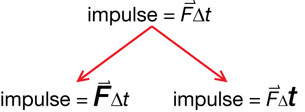 |
|
impulse |
impulse |
larger force and smaller time |
smaller force and larger time |
This idea can now be applied to the design of roadside barriers.
 Module 1: Lesson 2 Assignment
Module 1: Lesson 2 Assignment
Remember to submit the answers to A 4 to your teacher as part of Module 1: Lesson 2 Assignment.
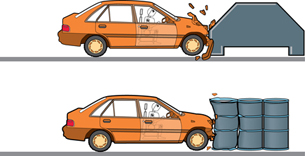
A 4. The illustrations show two ways of providing impulse to change the momentum of a vehicle. In the top illustration, the vehicle collides with a massive concrete barrier. In the bottom illustration, the vehicle collides with water-filled barrels.
Explain which type of crash barrier would likely produce less damage to the vehicle and less injury to the occupants.
1.10. Page 5
Module 1—Momentum and Impulse
Impulse Can Improve Sports Performance

© Michael Krinke/iStockphoto
This tennis player uses her racquet to change the momentum of the tennis ball. When she took her first tennis lessons, her coach explained that when hitting the ball with the racquet, it was important to continue to swing the racquet after contacting the ball. This technique is often referred to as using proper “follow through.” It is thought to be more effective than a shorter swing at giving the ball a high velocity.
 Read
Read
You can find out more about the role of impulse in improving sports performance by reading page 466 of your textbook.
 Self-Check
Self-Check
SC 8. Concisely explain why proper follow through increases the change in momentum of a tennis ball being struck by a tennis racquet.
 Self-Check Answer
Self-Check Answer
SC 8. To change the momentum of an object like a tennis ball, an athlete must supply an impulse to the ball. Since impulse is the product of the net force applied to the ball and the time interval during the interaction, the athlete attempts to maximize both the net force and the interaction time. The time interval is maximized by ensuring that the ball and the racquet are in contact for as long a time interval as possible. This is what the idea of proper follow through is all about.
1.11. Page 6
Module 1—Momentum and Impulse
Protecting Your Head

© Jim Wehje/Photodisc/Getty Images
The human skull is a thin layer of bone encasing the brain.
If you drop an expensive MP3 player onto a cement sidewalk, you might be disappointed if it no longer works, but at least you can have it repaired or replaced. There are many more on store shelves and the newer models often come with improved features. If you hit your head on a cement sidewalk, the long-term consequences could be much more serious. Although medical science has learned a lot about the workings of the brain, only so much damage can be repaired, and, unlike your MP3 player, an off-the-shelf replacement for your brain is out of the question.
People who are exposed to hazards that could lead to head injuries and possible brain damage take protective measures while at work or at play. In short, they wear helmets.

(left to right): Adam Crowley/Photodisc/Getty Images; Eyewire/Getty Images; Photodisc/Getty Images; Eyewire/Getty Images
Here are a few examples of how people protect their heads at work and at play.
Which activities do you participate in that require a helmet? Some possibilities include riding all-terrain vehicles (ATVs), playing hockey, downhill skiing, snowboarding, and inline skating. The activity that is probably on most lists is cycling. Since most people learn to ride a bicycle at a young age and can continue that activity into adulthood, the use of bicycle helmets has received public attention across Canada, including legislation for mandatory use.
Many people have strong opinions regarding the mandatory use of bicycle helmets. At the heart of the issue is this question: “What evidence is available to support the idea that the use of bicycle helmets significantly reduces head injuries among cyclists?” You will have an opportunity to answer this question in the next activity.
 Module 1: Lesson 2 Assignment
Module 1: Lesson 2 Assignment
Remember to submit the answers to D 2 to your teacher as part of your Module 1: Lesson 2 Assignment.
 Discuss
Discuss
In this activity you will use the Internet as a research tool.
D 1. What evidence is available to support the idea that the use of bicycle helmets significantly reduces head injuries among cyclists? Describe the overall trends in the data you collected.
D 2. Post your findings to the discussion area, and compare your findings with those of other students. How do their findings differ from yours? Are the arguments made to support these views consistent with the information you researched? Did other students find additional information unknown to you? Has your opinion of bicycle helmets changed since you started? Explain.
Principles involved: momentum |
||||
Criteria |
Level 1 (Below Standard) |
Level 2 (Approaching Standard) |
Level 3 (Standard) |
Level 4 (Above Standard) |
Knowledge |
||||
Demonstrates understanding of the situation, physics principles and technology, and their connections. |
Demonstrates a vague and sometimes incorrect understanding of the physics principles involved. Obvious irrelevant or missing information. |
Demonstrates a basic understanding of the physics principles involved. May exhibit minor mistakes or vague information or application to the situation. |
Demonstrates a good understanding of the physics principles involved and applies them properly to the given situation. All necessary information is given. |
Demonstrates a superior understanding of the physics principles involved and their application to the situation. All applications are considered in detail. |
Reflection |
||||
The post shows reflection on one’s own and other students’ work. Contributes to the group discussion. |
Does not make an effort to participate. Seems indifferent to discussion. |
Occasionally makes meaningful reflections on the group’s efforts or discussions. Marginal effort is shown to become involved with the group or discussion. |
Frequently makes meaningful reflections on the group’s efforts and presents relevant viewpoints for consideration by the group. Interacts freely with group members. |
Regularly attempts to motivate the group discussion and delve deeper into concepts. Interacts freely and encourages all group members. |
Content and presentation of discussion summary |
||||
The information is logically arranged in a clear and concise manner. |
The information is poorly organized with many concepts implied. Irrelevant or rambling sentences make reading difficult. |
The information is somewhat organized with implied concepts. Excessive words or awkward sentences are used, which hinder reading. |
The information is well-organized and logically arranged. All concepts are explicitly explained. There are a few awkward but understandable sentences. |
The information is well- organized and very easy to understand. Well-worded sentences make reading pleasurable. |
 Reflect on the Big Picture
Reflect on the Big Picture
Now that you understand impulse and how the product of net force and time will impact a situation, you understand how a helmet can prevent injuries when people are participating in sports and recreational activities. Using the concept of impulse, explain how a helmet prevents injuries when somebody participates in the sport or recreational activity of your choice. Save your explanation in your course folder.
1.12. Page 7
Module 1—Momentum and Impulse
 Module 1: Lesson 2 Assignment
Module 1: Lesson 2 Assignment
Submit your responses to the following parts of your Module 1: Lesson 2 Assignment to your teacher:
- Module 1: Lesson 2 Assignment
- Assignment—A 1, A 2, A 3, and A 4
- Discuss—D
 Lesson Summary
Lesson Summary
In this lesson you explored the following essential questions:
-
What is impulse?
-
How is impulse related to a change in momentum?
-
How is impulse used in the design of safety devices that protect the occupants of vehicles during a crash?
Impulse is the product of the net force applied to an object and the time interval during an interaction. Newton's second law can be used to demonstrate that the impulse applied to an object is equivalent to the change in the momentum of that object.
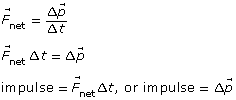

In the design of many safety devices, the force providing the impulse to an object or a person can be minimized if the time interval through which the force acts is maximized.
Lesson Glossary
impulse: the product of the net force applied to an object and the time interval during an interaction
The equation is as follows:
![]()
1.13. Module Summary/Assessment
Module 1—Momentum and Impulse
 Module Summary
Module Summary

© Joseph/shutterstock
Module 1 explored the concepts of momentum and impulse as they relate to the function and design requirements of vehicle safety devices. In particular, we examined the phrase “speed kills” and how it is possible to reduce injury and death when a vehicle occupant experiences a large change in momentum during a collision.
Within this context the following questions were examined:
- What is momentum?
momentum: the product of the mass and velocity of an object
It is expressed as an equation:
![]()
Quantity |
Symbol |
SI Unit |
momentum |
|
kg·m/s |
mass |
m |
kg |
velocity |
|
m/s |
-
Why is momentum defined as a vector?
Momentum is the product of a vector (velocity) and a scalar (mass), so it is a vector quantity. The direction of the momentum vector is the same as the direction of the velocity vector.
-
How is momentum related to Newton’s laws?
Newton’s second law explains that the external, non-zero, net force acting on an object will be equal to the rate of change of the momentum of that object. This has particular relevance to situations involving large changes in momentum, such as those of vehicle collisions that occur at a high rate of speed.
Module 1 also explored the working principles of safety devices in the context of the following questions:
- What is impulse?
-
How is impulse related to a change in momentum?
impulse: the change in momentum, ![]() , and the product of net force and time
, and the product of net force and time
It is expressed in equation form:
![]()
Quantity |
Symbol |
SI Unit |
| impulse | N·s or kg·m/s | |
| net force | N | |
| time | t | S |
momentum |
|
kg·m/s |
mass |
m |
kg |
velocity |
|
m/s |
Since force and momentum are vector quantities, impulse is a vector quantity. The direction of the impulse vector is the same as the direction of the net force vector.
- How is impulse related to Newton’s laws?
By applying Newton’s second law, impulse can be described in terms of a change in velocity, caused by a non-zero (unbalanced) net force.

Impulse may also be represented graphically in the form of a force-time graph. In such cases, the product of force and time, or the impulse, is represented by the area of the graph.
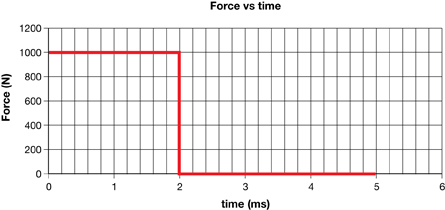
We also learned that the force associated with a given impulse can be reduced by applying it over a greater time period, a principle related to the design of vehicle safety devices such as air bags and crumple zones.
 Module Assessment
Module Assessment

© trialart-info/shutterstock

© Melissa Brandes/shutterstock
Car safety has changed dramatically since Karl Benz invented the first gasoline-powered vehicle in 1885. The first cars had no safety devices. Drivers had to wear goggles to protect themselves from hitting birds and insects while driving. Windshields were made of plate glass that would shatter into pieces if hit. Today we take it for granted that all cars have seat belts, safety glass, and airbags. There are even cars with multiple airbags, night vision systems, back up cameras and/or sonar and cars, such as the Volvo XC60, that will stop themselves to prevent collisions. Car designers, scientists, and engineers are even working on cars that will drive themselves in the future.
Most of the improvements in safety are the result of crash test information that comes from crash test dummies. Today’s crash test dummies are the culmination of many decades of testing. From human volunteers to animal cadavers to modern dummies, the technology to simulate dangerous crashes has improved dramatically. Modern dummies come in multiple sizes to simulate humans from small babies up to large adults; they have joints and move like their human counterparts but are full of sensors to measure the accelerations and forces that they experience during a crash to determine how dangerous the collision would be for real people.
In a crash test, two test dummies with a mass of 77 kg each are placed in the test vehicle. The driver dummy has a seatbelt while the passenger dummy does not have a seatbelt. The vehicle is placed on a track and run into a wall at 56 km/h. Upon impact, everything comes to a halt.
- Calculate the impulse for each dummy during the collision. (Analytic 5 marks)
- The seatbelt brings the driver dummy safely to a halt whereas the passenger stops violently by hitting the dashboard and windshield. Draw a force vs time graph to demonstrate an example set of forces working on each dummy and show that the graphed impulse for each dummy matches the previous calculations. (Graphing 5 marks)
- Describe why the graph for each dummy is different and how those differences show that the driver dummy stops safely and the passenger dummy does not stop safely. (Holistic 5 marks)
This module assessment is similar to the types of questions asked on a diploma exam. It is designed to examine your knowledge and application of several skills and concepts from the first module. Before submitting your solution read the following rubrics and self-assessment questions. These are the same rubrics as used on the diploma exam.
If you have any questions about the marking guides or the question itself contact your teacher for guidance.
Analytic Question Scoring Guide
Graphing Question Scoring Guide
1.14. Module Glossary
Module 1—Momentum and Impulse
Module Glossary
Consult the glossary in the textbook for other definitions that you may need to complete your work.
impulse: the product of the net force applied to an object and the time interval during an interaction
The equation is as follows:
![]()
momentum: is the product of the mass and velocity of an object
Expressed as an equation it is ![]() .
.




